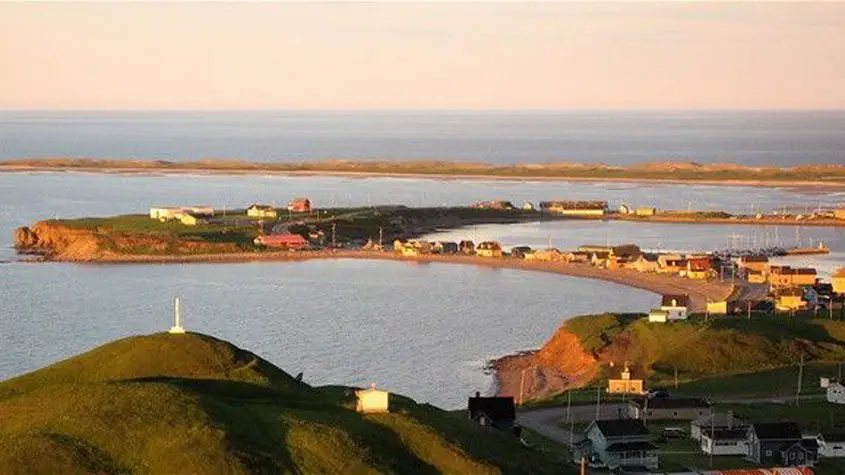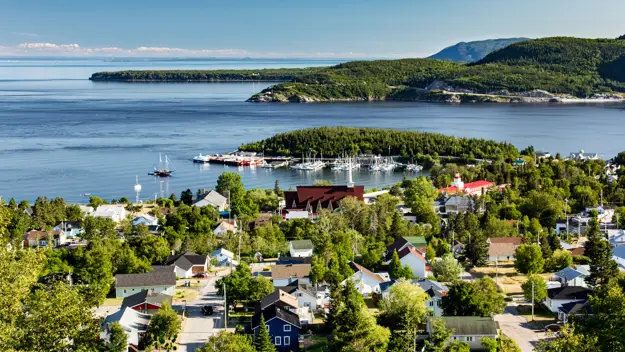The Magdalen Islands archipelago has much to offer in terms of activities and culture but its flora and fauna makes it a truly unique destination in the province.
The expedition to this small archipelago begins as the vessel proceeds down the St. Lawrence River. You will catch a glimpse of the first Islands midway between the shoals of the Gaspé Peninsula and Prince Edward Island. They are easily seen due to the bright and unique blood orange color of their beaches. As you approach the Magdalen Islands, you will be dazzled by the beauty of the cliffs and the surrounding landscapes.
The exact number of Islands is still not agreed upon. There are 5 to 7 depending on who you ask. With the CTMA cruises, you will have the pleasure of visiting each of the magnificent villages found on:
- L’île du Havre Aubert
- L’île de la Grande Entrée
- L’île du Havre-aux-Maisons
- L’île du Cap aux Meules
- L’île aux Loups
- L’île de Grosse-Île
- L’île de l’Est
Maritime climate
Lovers of seascapes will be delighted. The salty air, the dunes, the songs of whales and the ballet of the sea birds will immerse you with the beauty of the environment and the mild climate of the Islands.
There are more than 300 kilometres of beaches to be explored in the Magdalen Islands. Remember to bring your camera. Its red sand cliffs, located on the edge of the Islands, offer striking landscapes. This pigmentation, as well as the appearance of several salt domes on the banks, is due to the withdrawal of an ancient sea and several years of geological work. The dried sea left behind a thick layer of salt on which volcanic sediments have piled up. Since the sediments are denser, the salt rises to the surface in the form or bubbles or columns, forming these domes, which act as guardians of the Islands.
Once you explore a little farther, you’ll soon realize that the Islands also have wooded areas. A reforestation is currently ongoing to help the Islands regain their past lush vegetation. Even though this nature is no longer at the peak of its glory, it is home to a large number of small animals and a important variety of plants. There is also a variety of berries, including the Canadian dogwood, the pink streptopus, the glandular gadelier and the bramble of Mount Ida, raspberry tree.
Local flora
The Magdalen Islands have various environments that allow different types of plants to thrive. There are marshes and salt meadows where you find different kinds of grass, including the glasswort. The latter looks like a small cactus and its sea-taste make it a particular seasoning. In the peat bogs, ponds and freshwater marshes, you will also find insectivorous plants and beautiful blue irises. Fields and meadows flourish on the Magdalen Islands. In winter, these lands offer vast expanses of snow as far as the eye can see and in the summer, gorgeous wild flowers take their place. These numerous open spaces abound with white daisies, golden buttercups and yellow clovers, to only name a few.
Are you into gathering small wild berries? Here are some opportunities during the summer season:
- Field strawberries: from the second week of July in the fields and the edge of the woods
- Raspberries: end of July and early August in wooded areas and roadside
- Blueberries: August in the dunes and in wooded areas
- Cranberries: end of September in the dunes, the edge of ponds and in wet meadows
If you wish to explore the area for botanical purposes, we strongly recommend that you have a guide or a plants' manual during your exploration.
Islands residents
We are not referring to the Madelinots (who are very warm and endearing), but rather the small hairy occupants who have been living here for some time.
On the Islands, you may come across cute and clever red foxes. Their diet usually consists of deer mice and field voles. If you go to L’île du Havre Aubert, perhaps you will have the chance to see its canine cousin, the coyote. However, as they are very shy, it’s not easy to spot them.
A newcomer is the red squirrel. This rodent did not introduce itself, but was brought in by man. You will certainly come across this pretty little face if you visit L’ile-du-Havre-Aubert, Cap-aux-Meules or Havre-aux-Maisons, during your trip. This small agile climber adapted well to its new environment and, due to the low presence of predators, was very prolific. Its population is probably one of the highest in square kilometres. Other species have been introduced by humans, including the snowshoe hare. Once believed extinct, it is now back. Originally established on L’Île du Havre Aubert, the hare population now extends to Cap-aux-Meules. As for the American mink found near the ponds of Havre-aux-Basques, its arrival is accidental. Some of these little ones escaped from a breeding-farm and decided to take possession of this part of the territory.
Marine residents
If the terrestrial fauna interests you, wait until you meet the marine occupants. During your cruise, you will be able to see the colonies of seals who love to dry themselves in the sun along the banks. The gray seal and the harbour seal are there all year long, taking advantage of the St. Lawrence's River's moderate temperature. The gray seal differs mainly in size, it weighs 275 kilograms. Its nickname ''horse head'' is due to the elongated muzzle shape. His W-shaped nostrils, dark color and black head are another feature that distinguish him from the common seal. The latter is much smaller, weighing 90 kilograms, and paler in color. Its snout is shorter and its nostrils are V-shaped. Although the gray seal is a very important species, the harbour seal species is unfortunately declining and is now under surveillance. Both species can be seen in their natural environment at the end of Grande Échouerie beach, at Grosse-Île, at the Corps-Mort rock and at the end of the Dune-du-Sud beach, and just in front of the Grande-Entrée fishing port. Excursions are offered on site to allow you to approach them a little closer.
During the cold period, two other species are present. It’s in winter that the harp and hooded seals settle in the St. Lawrence River waters and give birth to their young white coats. They will unfortunately not be visible during the cruise since their presence in that region stretches only from December to March. Ask the Madelinots about these small white coats, they surely will have lots to tell you about this cute little animal. If you choose the Saveurs package, aboard your CTMA Vacancier cruise, you will visit the Centre d’interprétation du phoque. It’s a great opportunity to know more about with this emblematic mammal.
When you travel over the waters, you will sometimes see a fin or a tail in the distance. It could belong to either a whale or a dolphin. These rather social animals like to approach the vessels for a spontaneous greeting. Since they live in deep waters, they are visible only offshore. Several different species inhabit the river and here is how to distinguish them.
Minke whale
The minke whale can reach a length of 6 to 9 metres. It is seen moving alone but sometimes as a pair or a group. It is regularly spotted in the estuary from March to December. This strategic predator is very agile when it comes to capturing prey. It manoeuvres on the surface, often hunting very close to the coast and sometimes jumping out of the water. It is one of the most impressive species to watch.
Fin whale
Fin whales usually measure from 18 to 24 metres, sometimes more in southern waters. Like the minke whale, they like to be alone but can be seen in pairs or in groups. They feed in the area, over a seasonal period, from the month of May until the end of September. They are in ''big whales'' category and are also the fastest, which gives them their nickname of ''greyhounds of the seas''.
Atlantic white-sided dolphin
The white-sided dolphin, much smaller than our whale friends, measures from 2 to 2.7 metres. It is of gregarious temperament, so you will always see it moving in groups. It can be observed regularly during spring and fall. Very athletic, it moves quickly as it leaps out of the water. The yellow stripes on its flanks distinguish it from the other species of dolphins (the common dolphin and the blue and white dolphin) which could occasionally come into view.
Harbour porpoise
The porpoise is the smallest cetacean of the St. Lawrence River, with a length of 1.3 to 2 metres. Sometimes alone or in pairs, it moves mainly in groups of 5 to 10. In summer, from late June to September, they are frequently found in the estuaries, gulfs, fjords and also ports, hence its nickname ''Harbour porpoise''. Its life span, which is much shorter than the average, 20 years, seems to explain its urge to reproduce.
A bit of ornithology
There are more than 300 species of birds that live in the vicinity of the archipelago, enough to please avian fauna amateurs. The Magdalen Islands are home to a variety of natural environments, making it suitable for all these species. Excursions can be organized on the spot for those wish to observe some of them. Here are a few tips on how to choose the best locations.
Dunes and beaches
The beaches are, for certain species, the ideal place for nesting. That is why the dune ridges that criss-cross the Islands are favourable and attractive for them. From the end of April to mid August, you may spot an endangered species, the piping plover.
Freshwater ponds
The ponds, spread across the Islands, are a quiet haven for many nesting birds. Among them, you can identify ducks, rattles, herons, billed grebes and the kingfisher. On a seasonal basis, these sites also serve as staging areas for the brant goose, the great knight, the black-bellied plover and the golden plover.
Forest
The local forest, mainly populated with fir and spruce, attracts species that have a fondness for conifers. You will be able to see several of them sharing the territory, such as the black warbler, the fox sparrow, the boreal owl, the northern saw-whet owl, the forest troglodyte and the boreal chickadee.
The rare bird
If you plan on cruising in July, you may have the chance to meet shorebirds. These birds live mainly on the shores and feed on the plains. Several rare species can be seen on the Magdalen Islands, such as the Hansel tern, the red-neck sandpiper or the Curlew sandpiper. Several others can also be spotted such as the small and great knight, the Whimbrel, the Hudsonian godwit, the short billed dowitcher, the least sandpiper, the semipalmated sandpiper, the white-rumped sandpiper, the variable sandpipers, the grey-breasted Sanderling and the Red Knot.
Here is a list of recommended places to maximize your bird watching experience on the Magdalen Islands:
- La Martinique, the whole area between the West dune (Coulombe Road to Étang-du-Nord) and the beach of La Martinique (along route199)
- The Point-de-l’Est National Wildlife Reserve accessible by the trails of L’Échouerie and the Marais salés
- L’île aux Goélands to L’Étang-du-Nord (Delaney Road)
- L’île Paquet, called « aux Cochons », next to the Havre-aux-Maisons marina
- L’île Rouge, next to the bridge connecting l’île du Cap aux Meules to Havre aux Maisons
- The cliffs of l’île d’Entrée
- The Parc des Buck trail for the observation of birds in the forest
You will also have the pleasure of passing in several areas favourable to bird watching by bike. Be alert and keep your eyes open, you may have some surprising encounters along the way.
When booking with Voyages AML, consider planning your trip according to the adventure you wish to experience and the encounters you would like to have. Depending on the time of year, you choose to go on the Islands, some animals will be easier to observe and you will increase your chances of meeting others. The same goes for flowering periods and related activities. Your trip to the Magdalen Islands promises to be an absolutely unforgettable experience no matter what!




